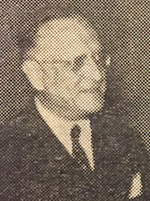Clarence E. Gauss (original) (raw)
From Wikipedia, the free encyclopedia
American diplomat
| Clarence E. Gauss | |
|---|---|
 |
|
| United States Ambassador to the Republic of China | |
| In officeMay 26, 1941 – November 14, 1944 | |
| President | Franklin D. Roosevelt |
| Preceded by | Nelson T. Johnson |
| Succeeded by | Patrick Hurley |
| 1st United States Minister to Australia | |
| In officeJuly 17, 1940 – March 5, 1941 | |
| President | Franklin D. Roosevelt |
| Preceded by | Diplomatic relations established |
| Succeeded by | Nelson T. Johnson |
| Consul General of the United States, Shanghai | |
| In office1935–1940 | |
| President | Franklin D. Roosevelt |
| Preceded by | Monnett Bain Davis |
| Succeeded by | Frank P. Lockhart |
| Personal details | |
| Born | Clarence Edward Gauss(1887-01-12)January 12, 1887Washington D.C. |
| Died | April 8, 1960(1960-04-08) (aged 73)Los Angeles |
| Political party | Republican |
Clarence Edward Gauss (January 12, 1887 – April 8, 1960)[1] was an American diplomat.
Personal background
[edit]
Gauss was born in Washington, D.C., as the son of Herman Gauss and Emile J. (Eisenman) Gauss. He married Rebecca Louise Barker in 1917. He was a Republican and a Protestant.
Frank P Lockhart, Gauss, Admiral William A. Glassford and RJ McMullen in Shanghai 1941
British Judge Sir Allan Mossop and Gauss in Shanghai in 1939
Gauss was a career Foreign Service Officer for the United States Foreign Service. He was posted as U.S. Vice Consul in Shanghai, 1912–15; U.S. Consul in Shanghai, 1916; Amoy, 1916–20; Jinan, 1920–23; U.S. Consul General in Mukden, 1923–24; Jinan, 1924–26; Shanghai, 1926–27 (acting), 1935–38; Tianjin, 1927–31; Paris, 1935; Shanghai, 1935-1940. From 1940-41 he served as U.S. Minister to Australia, and was the United States ambassador to the Republic of China during the Second World War.[2] He resigned from the post in November 1944, and was replaced by Patrick Hurley.
U.S. Vice Consul
- Shanghai, 1912–15
U.S. Consul
U.S. Consul General
- Mukden (now Shenyang), 1923–24
- Jinan, 1924–26
- Shanghai, 1926–27 (acting), 1935–38
- Tianjin, 1927–31
- Paris, 1935
- Shanghai, 1935-1940
U.S. Minister
- Australia, 1940-1941
U.S. Ambassador
- China, 1941-1944
After leaving diplomatic service, Gauss was director of the Export–Import Bank of the United States. He died at Good Samaritan Hospital in Los Angeles on April 8, 1960.[3]
- ^ The United States in Asia: A Historical Dictionary
- ^ U.S. Department of State, Office of the Historian. Gauss Clarence Edward
- ^ "Former U.S. Ambassador to China, Australia Dies". Los Angeles Times. April 9, 1960. p. 3. Retrieved April 18, 2020 – via Newspapers.com.
| Diplomatic posts | ||
|---|---|---|
| Preceded byNelson T. Johnson | US Ambassador to China 1941–1944 | Succeeded byPatrick Hurley |
| Preceded byfirst incumbent | U.S. Ambassador to Australia 1940–1941 | Succeeded byNelson T. Johnson |

